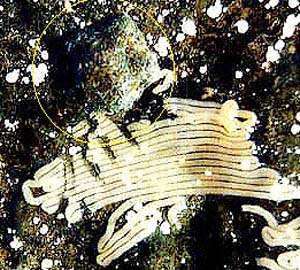Egg predation
Related messages
Aplysia egg masses as potential fish food
May 31, 2006
From: Philip Bodington
I operate a marine fish hatchery for the Mediterrnaenean Sea Bream (Sparus aurata) and have many sea hares (probably Aplysia punctata ) breeding in my inlet resrvoir tank as well as the outlet settlement lagoon.
I have never observed prdation on the egg massses even though the outlet lagoon is full of various fish species.As I am always looking for alternative sources of nutrition for my broodstock, I plan to get the egg masses analysed for their nutritional profiles.
I was curious to know if there would be a problem with feeding the egg masses in my inlet water to the breeders, or should I expect some adverse reaction due to some protective mechanism.
Are sea hare egg masses ever use in human comsumption?
Locality: Gulf of Corinth, 20cm, Greece, Mediterranean, Spring and Summer. Length: 2cm-7cm
Philip Bodington
bodaqua@otenet.gr
Bodington.P, 2006 (May 31) Aplysia egg masses as potential fish food. [Message in] Sea Slug Forum. Australian Museum, Sydney. Available from http://www.seaslugforum.net/find/16723Dear Phil,
You might like to look out the following publication which reviews a lot of the literature.
-
Johnson, P.M & Willows, A.O.D, (1999) Defense in Sea Hares (Gastropoda, Opisthobranchia, Anaspidea): multiple layers of protection from egg to adult. Marine & Freshwater Behaviour & Physiology, 32: 147-180.
In brief, the few studies that have been done report the egg masses of a number of sea hare species being rejected by crabs and reef fish. However it does not seem to be secondary metabolites from their algal food, or algal pigments which make the eggs distasteful. Basically, what makes them distasteful is a mystery.
There is a message on the Forum [#3047] reporting the eggs being eaten by people in the Philippines, and I am pretty sure Dolabella eggs are eaten in Fiji. See also see Kirsten Benkendorff's message [#3065] summarising the most recent research.
My advice would be that before you spend money on nutritional assays, you should do a simple taste test with the fish. It seems quite likely that they will reject the eggs, no matter how nutritious they are.
Best wishes,
Bill Rudman
Egg predation - Dolabrifera
April 8, 1998
From: Kirsten Benkendorff

Hi Bill,
I have enclosed a photo of what looks like predation on some Dolabrifera egg ribbons by the starfish Pateriella exigua. I have only ever observed this once so if anyone else has seen something like this could you please let me know. I am interested in any form of predation on any mollusc egg masses.
Thanks,
Kirsten Benkendorff
Department of Biological Science,
University of Wollongong,
NSW 2522
kb06@uow.edu.au
Benkendorff, K., 1998 (Apr 8) Egg predation - Dolabrifera. [Message in] Sea Slug Forum. Australian Museum, Sydney. Available from http://www.seaslugforum.net/find/56Note: The egg ribbon is of Dolabrifera brazieri. 24 April 2003
Dear Kirsten,
I have passed your query on to Maria Byrne at Sydney University who is an expert on the biology of Patiriella. Patiriella exigua is considered a herbivore and the scrape or tear marks in your photo don't look like they have been done by a starfish which exudes its "stomach" out when feeding and digestive enzymes dissolve the food in situ. To those who don't know, Patiriella exigua is a common little five-armed starfish found from New South Wales around to South Australia. I have put a yellow ring around the "suspected villain" in the photo Kirsten sent me. Has anyone else seen something similar?.. Bill Rudman.
